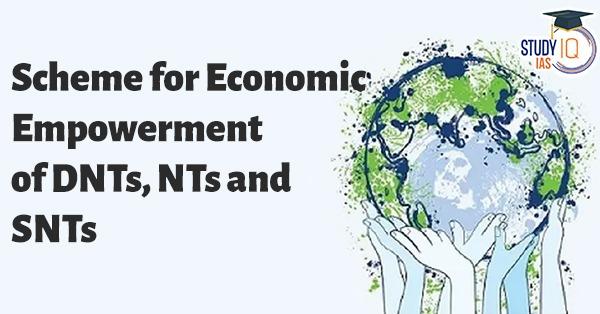Table of Contents
About the Scheme for Economic Empowerment of DNTs
- As per the latest estimates with the government, more than 10 crore Indians from 1,400 communities belong to these group of (DNTs/NTs/SNTs).
- But none of the applications received so far on Scheme for Economic Empowerment of DNTs online portal have been approved yet.
- As per government officials, the exercise to bring all DNT, NT and SNT communities under SC, ST, and OBC categories is holding up the implementation of the Scheme for Economic Empowerment of DNT scheme.
- Same communities are in different list in different states. For example, some communities like the Banjara people were under the SC list in Delhi, the ST list in Rajasthan and the OBC list in Uttar Pradesh. Also, some communities were under different lists in different districts even within the same State.
- Also, different generations of the same community had been issued different community certificates. The difference in spelling of communities based on local dialects also prevented many of them from getting a community certificate.
- The Development and Welfare Board for De-notified, Nomadic and Semi-Nomadic Communities (DWBDNC) is the agency working with the list of DNTs/NTs/SNTs.
- The list was enumerated by the Bhiku Ramji Idate Commission, which listed 1,262 such communities and categorized them under SC/ST or OBC and others.

About De-notified, Nomadic and Semi-Nomadic Tribes
- The term ‘De-notified Tribes’ stands for all those communities which were once notified under the Criminal Tribes Acts, enforced by the British Raj between 1871 and 1947.
- These Acts were repealed after Independence in l952, and these communities were “De-Notified”.
- There are nearly 1,500 nomadic and semi-nomadic tribes and 198 denotified tribes, comprising 15 crore Indians, according to the Renke Commission, 2008.

Scheme for Economic Empowerment of DNTs , NTs and SNTs: Issues Faced
- They are the most neglected, marginalized and economically and socially deprived communities.
- Most of them have been living a life of destitution for generations and continue to do so with an uncertain and gloomy future.
- Historical background: The misery of these communities began with the enactment of the Criminal Tribes Act, 1871 during the British rule.
- These communities were subjugated, persecuted and neglected.
- This led to the forcible alienation from their traditional occupations and habitations. They remained hunter gatherers and pastoral/peripatetic.
- Even after the Independence; they have not benefitted much from the planned development of over seven decades.
Scheme for Economic Empowerment of DNTs: Chronology of Government Efforts

About the Scheme for Economic Empowerment of DNTs, NTs and SNTs (SEED)
- Major components: The four component of the SEED scheme are:
- Educational empowerment- Free coaching to students from these communities for Civil Services, entry to professional courses like medicine, engineering, MBA, etc.
- Health Insurance through PMJAY of National Health Authority.
- Livelihoods to support income generation, and
- Housing (through PMAY/IAY)
- Implementing agency: The DWBDNCs has been tasked with the implementation of this scheme.
- Who are eligible? Those families having income from all sources of Rs.2.50 lakh or less per annum and not availing any such benefits from similar Scheme of Centre Government or the State Government.
- Outlay and time period: The scheme will ensure expenditure of Rs.200 crore to be spent over five years beginning 2021-22.
- Online portal: This portal will ensure seamless registration and will also act as a repository of the data on these communities. The portal is very user friendly and easily accessible on mobile phone with its mobile application. It will provide real time status of the application to the applicant.
- The payment to the beneficiaries will be made directly in to their accounts.





















 WhatsApp
WhatsApp